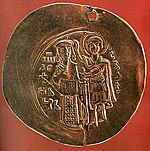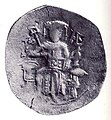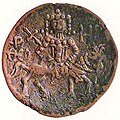Medieval Bulgarian coinage

Medieval Bulgarian coinage were the coins minted by the Bulgarian Emperors during the Middle Ages at the time of the Second Bulgarian Empire.
There is no evidence that coins were minted during the
Ivan Asen II
Tsar
- Gold Thessalonicamint, which was at the time under Bulgarian rule.
The uniqueness of Ivan Asen's gold perpera and the peculiarity of its iconography have led a minority of researchers to doubt its authenticity.[1] Its peculiarity is the double gesture of Saint Demetrius who simultaneously crowns the Emperor and gives him a sword, an image found in no Byzantine or other Slavonic coins.
- Billon coins - There are around one hundred preserved coins of that type. On one side is the image of the Emperor and Saint Demetrius upright and holding a scepter with a star. On the other side is depicted Christ Pantocrator. These coins were probably minted in the Thessalonica mint. Their weight is between 3.00 and 3.08 grams.
Mitso Asen
- Billon coins - On one side is depicted the Emperor in 3/4 length, holding a cross in his left and a scepter in his right hand. On the other side is Saint Nicholas in half-length. The inscription "Saint Nicholas" is in Greek. The saint is protector of the sailors and was a patron of the Emperor probably because the personal lands of Mitso Asen (1256–1257) included the port of Nesebar and its environs.
Constantine Tikh Asen
The coinage of that ruler is distinguished by its variety, the use of new iconographic types and the precise engraving.
- Billon coins
- First type: Obverse - Christ Emanuil; reverse - the Emperor in 3/4 length.
- Second type: Obverse - large Latin Cross; reverse - the Emperor on a throne without back, inscription in Bulgarian "Konstantin, Tsar Asen".
- Third type: Obverse - Christ Ubrus and ligature inscription "Jesus Christ"; reverse - the Emperor on horseback, inscription in Bulgarian "Konstantin, Tsar Asen". For the first time in Bulgarian coins the ruler is depicted on a horse. The iconographic type "Urbus" (Mandylion) is unique for Byzantine-Slavonic coinage.
- Fourth type: Obverse - Christ Pantocrator; reverse - the Emperor on horseback with inscription in Bulgarian "Constantine, Tsar Asen".
- Fifth type: Obverse - Hagioritissa; reverse - the Emperor upright holding a scepter in his right hand. Weight - 3,04 g; diameter - 26,25 mm. There are few preserved coins of that type.
- Sixth type: Obverse - Christ Pantocrator; reverse - the Emperor upright.
- Seventh type: Obverse - Constantine Tikh Asen(1257-1277) because the inscription of the preserved item is damaged and only the word "Tsar" can be read.
-
Billon coin depicting a Latin cross
-
Billon coin depicting Constantine Tikh Asen on a throne
-
Billon coin depicting Constantine Tikh Asen on horseback
George I Terter
- Billon coins: Obverse - Christ on a throne; reverse - George I Terter (1280–1292) and his son Theodore Svetoslav as co-emperors. They are upright in full length holding together a flag or a cross.
Theodore Svetoslav
Theodore Svetoslav (1300–1321) was the first Bulgarian ruler who minted silver coins called aspra (from Greek aspron, meaning "white").
- Silver coins: Frontage - Christ Pantocrator sitting on a throne; reverse - the Emperor upright holding a cross, and inscription in Bulgarian "Svetoslav, Tsar of the Bulgarians". Its weight is 1,53 G. There three emissions of that type which differ in the quality of the engraving.
- Billon coins: Frontage - large Latin Cross; reverse - the Emperor on a mantle. There are two emissions made by different engravers. The inscriptions are in Bulgarian and abbreviated and say: "Theodore" and "Svetoslav Theodore".
-
Billon coin depicting Theodore Svetoslav on horseback
-
A silver coin of Theodore Svetoslav
Michael Shishman

- Silver coins: Obverse - Christ Pantocrator sitting on a throne with high back; reverse - the Emperor on horseback, with inscription "Michael Tsar". Many of the coins of Michael Shishman (1323–1330) were later re-minted as coins of Ivan Alexander (1331–1371).
Ivan Alexander
- Silver coins:
- First type: Obverse - Christ Pantocrator sitting on a throne; on the reverse, the Emperor upright holding a scepter and a sphere with a cross. There is an inscription in Bulgarian "Alexander, Tsar of the Bulgarians". There are several varieties depending on their weight and the engraving.

- Second type: Obverse - Christ upright in full-length, blessing with two hands; reverse - Ivan Alexander and his son suzerainIvan Alexander, adding his signs.
- Second type: Obverse - Christ upright in full-length, blessing with two hands; reverse - Ivan Alexander and his son
- Copper coins:
Some of the copper coins of Ivan Alexander are hollow (stamini) and others are flat (asarioni).
- First type: Obverse - a monogram of Ivan Alexander; reverse - the Emperor on a horse.
- Second type: Obverse - a monogram of Ivan Alexander; reverse - the Emperor upright in full length holding a scepter and a sphere with cross.
- Third type: Obverse - monograms of the name and the title of Ivan Alexander; on the reverse, the Emperor upright in 3/4 length.
- Forth type: Obverse - a depiction of a coat-of-arms of Veliko Tarnovo.
- Fifth type: Obverse - a trident-shaped monogram resembling the monograms of Michael Shishman; on the reverse, Ivan Alexander and Michael Asen holding together a cross.
- Sixth type: Obverse - monograms the name and the title of the monarch; on the reverse - Ivan Alexander and Empress Theodora together holding a cross. There are three varieties of that common coin.
- Seventh type: Obverse - Christ Pantocrator on a throne; on the reverse, Michael II Asen.
- Eight type: Obverse - a cross with acanthine leaves; on the reverse - Ivan Alexander upright in full length. There are several varieties which differ in the weights and the quality of engraving.
- Ninth type: Obverse - a cross with acanthine leaves; on the reverse - a double-headed eagle. It is not proven whether these coins belong to Ivan Alexander. The engraving is of very high quality.
- Tenth type: Obverse - an Orthodox cross; on the reverse, a monogram-trident identical to that in the copper coin of the Emperor and his son Michael Asen.
Michael Asen

- Silver coins:
- First type: Obverse - Christ on a throne; on the reverse - Michael Asen and Saint Stephen upright holding a flag. The coin somewhat resembles the Venetian ducats. The names of the Prince and the Saint are written in different ways in the different varieties of the coin. The weight is from 1.40 g to 1.90 g.
- Second type: Obverse - Christ on a throne; on the reverse - Michael Asen and his wife Irina holding a flag. According to some researchers, the coins are from Michael II Asen and his mother Irina Komnina. There are two varieties of that coin. In the second variety Michael Asen and his wife hold a cross instead of a flag. The inscription is in Bulgarian and says "Irina Tsaritsa, Mihail Tsar". The weight varies from 1,50 G to 1,80 G.
- Copper coins:
- First type: Obverse - Bust of Christ Pantocrator; on the reverse - Michael Asen upright in full length with inscription in Bulgarian "Mihail Tsar". That coin in considered as part of Michael Asen's coinage due to the similarities of the engraving technique with the coins of Ivan Alexander.
- Second type: Obverse - monogram-trident; on the reverse, Michael Asen on a horse. According to some research, the coin is of Michael Shishman.
See also
Sources
- "Българските средновековни монети" - Стоян Авдев, издателство "БЕСИКЕ", София 2007 г.
- "Българските монети" - Христо Божков, Венцислав Пейков, издателство "Борина", София 1993 г.
References
- ^ "Златната монета на Иван Асен ІІ"- статия на Георги Гъбев в електронно списание "Будител"





